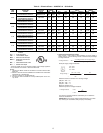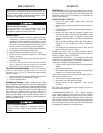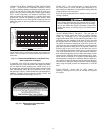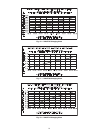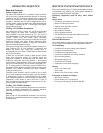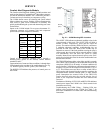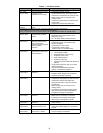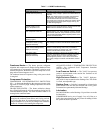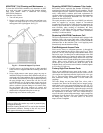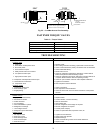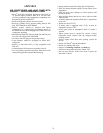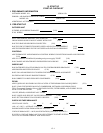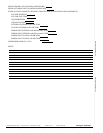
22
NOVATION™ Coil Cleaning and Maintenance —
To clean the NOVATION condenser coil, chemicals are NOT
to be used; only water is approved as the cleaning solution.
Only clean potable water is authorized for cleaning
NOVATION condensers.
Clean the coil as follows:
1. Turn off unit power.
2. Remove screws holding rear corner posts and top cover
in place. Pivot top cover up 12 to 18 in. (305 to 457 mm)
and support with a rigid support. See Fig. 21.
Fig. 21 — Pivot and Support Top Cover
3. Carefully remove any foreign objects or debris attached
to the coil face or trapped within the mounting frame and
brackets.
4. Using a high pressure water sprayer, purge any soap or
industrial cleaners from hose and/or dilution tank prior to
wetting the coil.Clean condenser face by spraying the coil
core steadily and uniformly from top to bottom, directing
the spray straight into or toward the coil face. Do not
exceed 900 psig or a 45 degree angle; nozzle must be at
least 12 in. (30 cm) from the coil face. Reduce pressure
and use caution to prevent damage to air centers (fins).
Do not fracture the braze between air centers and
refrigerant tubes. Allow water to drain from the coil core
and check for refrigerant leaks prior to start−up.
5. Replace top cover and rear corner posts.
Repairing NOVATION Condenser Tube Leaks
RCD offers service repair kit Part Number 50TJ660007 for
repairing tube leaks in the NOVATION coil crosstubes. This kit
includes approved braze materials (aluminum fluxcore braze
rods), a heat shield, a stainless steel brush, replacement fin
segments, adhesive for replacing fin segments, and instructions
specific to the NOVATION aluminum coil. See EPIC for
instruction sheet 99TA526379.
The repair procedure requires the use of MAPP gas and torch
(must be supplied by servicer) instead of conventional
oxyacetylene fuel and torch. While the flame temperature for
MAPP is lower than that of oxyacetylene (and thus provides
more flexibility when working on aluminum), the flame
temperature is still higher than the melting temperature of
aluminum, so user caution is required. Follow instructions
carefully. Use the heat shield.
Replacing NOVATION Condenser Coil
The service replacement coil is preformed and is equipped with
transition joints with copper stub tubes. When brazing the
connection joints to the unit tubing, use a wet cloth around the
aluminum tube at the transition joint. Avoid applying torch
flame directly onto the aluminum tubing.
Field Refrigerant Access Ports
Field service access to refrigerant pressures is through the
access ports located at the service valves (see Fig. 6). These
ports are ¼-in SAE Flare couplings with Schrader check valves
and service caps. Use these ports to admit nitrogen to the field
tubing during brazing, to evacuate the tubing and evaporator
coil, to admit initial refrigerant charge into the low-side of the
system and when checking and adjusting the system refrigerant
charge. When service activities are completed, ensure the
service caps are in place and secure; check for leaks. If the
Schrader check valve must be removed and re-installed, tighten
to 2-3 in-lbs (23-34 N-cm).
Factory High-Flow Access Ports
There are two additional access ports in the system - on the
suction tube between the compressor and the suction service
valve and on the liquid tube near the liquid service valve (see
Fig. 6). These are brass fittings with black plastic caps. The
hose connection fittings are standard ¼-in SAE Male Flare
couplings.
The brass fittings are two-piece High Flow valves, with a
receptacle base brazed to the tubing and an integral spring-
closed check valve core screwed into the base. (See Fig. 22.)
This check valve is permanently assembled into this core body
and cannot be serviced separately; replace the entire core body
if necessary. Service tools are available from RCD that allow
the replacement of the check valve core without having to
recover the entire system refrigerant charge. Apply compressor
refrigerant oil to the check valve core's bottom o-ring. Install
the fitting body with 96 ±-10 in-lbs (1085 ±23 N-cm) of
torque; do not overtighten.
PERSONAL INJURY HAZARD
Failure to follow this caution may result in personal injury
or equipment damage.
Chemical cleaning should NOT be used on the aluminum
microchannel condenser. Damage to the coil may occur.
Only approved cleaning is recommended.



